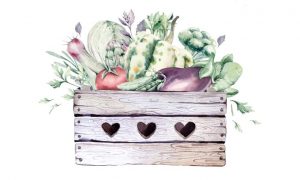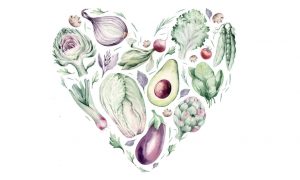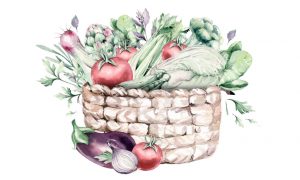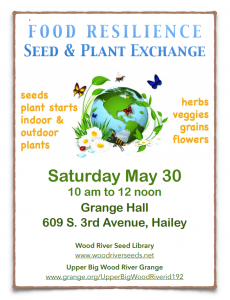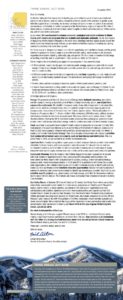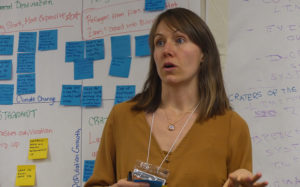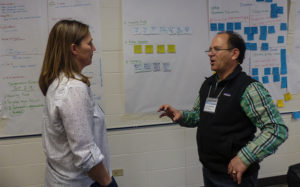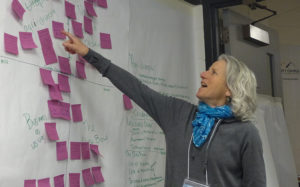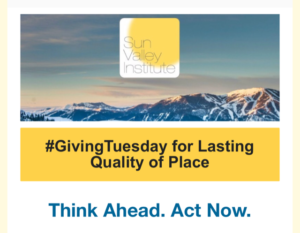Blaine County
Sharing sustenance.
May 12, 2020Instead of Buying Guns or Hoarding Food, Let’s Feed Each Other
YES! Magazine/Solutions Journalism
by Michele Bigley
From my patio in Santa Cruz, California, I watched a scrub jay deliver a peanut shell to its oak-tree home. My neighbor hollered hello from the street below, explaining that she was afraid to go to the store for groceries. “A person was held at gunpoint at the Target,” she said. “Everyone’s going crazy.”
My grandparents had “war gardens” in the 1940s, and small, potted remnants from that time took root on their patios well into their golden years. I’d often asked them to teach me how to grow veggies. But they argued that because grocery store shelves were fully stocked again, they didn’t think it was necessary to teach me how to put in the work of growing my own food.
Yet now our local farms have waiting lists for their Community Supported Agriculture weekly deliveries.
We can plant seeds that take a little weight off our overburdened food system and grocery store workers.
Inspired by all this generosity, I wanted to go beyond simply planting a victory garden for my family’s sustenance. I wanted the sustenance to be shared, so I sent out a blast on Nextdoor.com. Within minutes, people offered up compost bins, some more seeds and soil, starter pots. My septuagenarian neighbors brought over tools, advice, and veggie starts. Another guy I didn’t even know was scavenging scrap wood from a construction site nearby; when I asked about how to make a garden bed, he lugged over some wood, and constructed one in my yard.
The retired crisis therapist across the street noticed the raised bed and said, “In the news, we’re seeing the worst of humanity right now, but around us we’re experiencing extreme acts of kindness, too.”
Many Americans have been raised with this ethos of individualism. I, too, was taught to take care of my family above all else. With the threats of joblessness and hunger in every community, I get that urge to protect what’s ours, especially when we’re terrified that a stranger’s cough can land us in the ICU.
But in the 1930s and 1940s, 20 million Americans stepped up in a time of great global terror. They planted gardens in abandoned lots, on patios, and on rooftops. Today, too, we have the potential to shift how we engage with our world. In fact, social distancing requires it. We can broaden our perspectives and open our hearts to people with whom we might share nothing more than proximity. They will be the ones there for us in crisis. They will deliver chicken soup if we’re sick. They will check in on us if they don’t see us out and about. And they will let us know when the grocery store finally has some Clorox wipes.
Now six weeks into our shelter-in-place, the spinach and strawberries, tomatoes and kale, cucumbers and peppers are sprouting. When I called my neighbor to revel in these tiny green victories, she told me to look on my front stoop. There, I found a pack of toilet paper
Blaine County IDAHO Local Food Alliance
sunvalleyinstitute.org
DIGITAL FOOD GUIDE
Help us connect you with farms and ranches, farmers markets, and restaurants serving locally grown food! The new print version of our 2020 Wood River Valley Locally Grown Guide will hit local magazine stands, visitors’ centers and other regional venues in a matter of days. Now, we are updating our online food guide to include all the same business and non-profit listings, visuals and links, so community members and visitors can find local food with a few simple clicks.
Sun Valley Begins Antibody Testing
April 8, 2020You have a chance to help others. We have just announced the start of a clinical study to test for COVID-19 antibodies in our community. Please CLICK HERE for the press release. The clinical study is part of a collaboration with Albany College of Pharmacy and Health Sciences and the Fred Hutchinson Cancer Research Center to help further the fight against COVID-19. We are asking for volunteers to help with the research. Initially we are looking for 400 volunteers, although that could be increased in the future.
Teamwork – that is what makes things happen. There are too many people to mention that have helped initiate this exciting academic study – and we are just getting started! Through community relationships, experts in the field and highly respected academic institutions, we have managed to put together a team of leading epidemiologists. However, it all starts at home. Fire Chief Bill McLaughlin and Blaine County Emergency Medical Director Terry O’Conner are spearheading this initiative. Further afield, we are delighted to be partnering with two outstanding academic institutions – I am thankful for the local connections that made this possible.-Ketchum Mayor Neil Bradshaw
Antibody Study and Testing Begins in Blaine County
KETCHUM, Idaho – The Ketchum Fire Department and Blaine County Ambulance District have partnered with the Albany College of Pharmacy and Health Sciences, and the Fred Hutchinson Cancer Research Center to conduct a study that includes antibody testing for residents of Blaine County.
The study will start with a random sample of 400 Blaine County residents to determine the prevalence of COVID-19 antibodies in symptomatic and asymptomatic individuals to determine how many asymptomatic, or silent, cases there are in the community.
Officials emphasize this is a study; not a medical diagnosis, vaccine or guarantee of immunity to COVID-19.
Initially, the study will analyze the total number of COVID-19 cases in the sample group compared to the number of cases tested. This information will help further the fight against COVID-19 to help scientists slow or stop the disease. It will also help discover if antibody presence confers immunity.
Blaine County residents wishing to participate in the study, including the testing, may register at https://redcap.acphs.edu/surveys/?s=3MDMEDTX4L. Residents will be screened and chosen for the study based on demographic criteria established for the study.
Eventually, the study will provide information to the community on when it is safe to resume normal activity.
“We are grateful for the efforts led by Ketchum Fire Chief Bill McLaughlin and Blaine County EMS Director Terry O’Connor to spearhead this study,” said Mayor Neil Bradshaw. “A keen interest from the partnering organizations and the perseverance of our Chief and EMS Director kept the ball rolling and made the testing a reality for our community.”
Further analysis of the study will help to:
- Determine whether there are indicators for predicting a mild or severe reaction to COVID-19
- Determine the transmissibility of the virus
- Predict the duration of a COVID-19 outbreak and whether herd immunity can be reached in a community
- Develop vaccines for COVID-19
- Determine if there is a correlation between certain classes of blood pressure medication and severity of illness
“I am proud of the collaboration between Blaine County and our cities,” said Blaine County Commissioner Jacob Greenberg. “Not only will this testing in the County help the study, it is a chance for the volunteers to help friends, relatives, neighbors and ultimately, all of humanity.”
https://www.crushthecurveidaho.com
WHAT IS CrushTheCurveIdaho.com?
Providing COVID-19 testing to workers deemed essential during this global pandemic.
CrushTheCurveIdaho.com is a coordinated effort by Idaho businesses, innovators, and leaders to reduce the spread of COVID-19. Our mission is to procure testing specifically for Idaho companies to make it easier for essential workers to be tested. We have access to a large supply of test kits and are currently working to secure an antibody test that will be available soon.
WE ARE NOT a replacement for traditional doctors offices and others doing testing for individuals with symptoms or who meet other testing requirements.
GET TESTED.
SAVE LIVES.
GET BACK TO WORK.
From Dr. Archie
April 3, 2020B L A I N E I D A H O
From – Tom Archie MD, Ketchum, Idaho
Summary
COVID19 Transmission Edition
This is a single-issue edition of the InnerHealthMD Pulse. It is dedicated to the topic of how early and how long the SARS-CoV-2 virus is spread from infected individuals to others who have not yet been exposed.
I explain my rationale for….
a) early self-quarantine if suspicious of symptoms
b) early self-quarantine if someone in your house has suspicious symptoms
c) how long to remain in self-quarantine, and
d) why I disagree with CDC recommendations for duratation of self-quarantine and with hospital systems using CDC guidelines to recommend ending quarantine for known cases (or for symptom-probable cases).
There are links to original journal articles, all reported in March 2020.
I encourage individuals, physicians, and especially employers to review this information when establishing return-to-work (or return-to-grocery-shopping) timelines.
There are links to original journal articles, all reported in March 2020:
Surface Contamination &
Aerosolization
In a detailed study of 13 COVID19 patients at Nebraska Medical Center’s quarantine unit, most of whom had mild disease, 40 surfaces were repeatedly checked for the SARS-CoV-2 virus
The following were positive for the coronavirus:
-76.5% of all personal items 81.3% of exercise equipment, medical equipment (spirometer, pulse oximeter, nasal cannula), personal computers, iPads and reading glasses (mean of 0.217 copies/mcL)
-83.3% of cell phones (mean of 0.172 copies/mcL)
-64.7% of TV remote controls (mean of 0.230 copies/mcL)
-81% of samples from toilets (mean 0.252 copies/mcL)
-80.4% of all room surface samples
-75% of bedside tables and bed rails
-81.8% of the window ledges (mean concentration 0.219 copies/mcL)
-100% of all under-the-bed floor samples (mean of 0.447 copies/mcL)
-80% of ventilation grate samples (mean of and 0.819 copies/mcL)
-63.2% of in-room air samples (2.86 copies/L of air) – including well beyond 6 feet away
-66.7% of hallway air samples – outside-patient-confined rooms (transported by medical staff)
Virus found in GREATER amounts where drifting by air than on items touched
Virus was found on surfaces obviously not touched by patients (under the bed, window ledges) following air flow and eddies. Airflow modeling results strongly suggest that “virus expelled from infected individuals, including from those who are only mildly ill, may be transported by aerosol processes in their local environment, potentially even in the absence of cough or aerosol generating procedures.”
BOTTOM LINE If you have a new illness, please stay home until it is gone and stays gone for as long as 3-4 weeks after symptoms started. Help reduce spread!
In a study of 23 COVID19-hospitalized patients in Hong Kong,
Saliva viral load highest in the week 1 and declined with time
Longest viral shedding 25 days after symptom onset.
-50% of severe case shed virus in saliva >20 days
-23% of mild cases shed virus in saliva >20 days. C
-38% of severe cases shed virus in stool > 20 days
-14% of mild cases shed virus in stool > 20 days
There was no virus found in urine samples.
In a study of 9 COVID19-hospitalized patients in Germany, which included interesting observations on the ability to grow virus in culture after obtaining it from patients at different stages of disease
Virus found in throat, lung and stool but never in blood or urine.
Patients initially had mild symptoms of a common cold.
Nasal swab PCR tests positive in all cases on Day 1-5 of symptoms.
Antibodies IgM & IgG first detected on Day 6-12 of symptoms.
Longest viral shedding 22 days from onset
Slow, steady decline in the amount of virus in samples over 22 days
Efforts to grow virus from patient samples in the lab were more successful in the first week of symptoms.
Despite high viral loads found on nasal sampling in later weeks, virus was not able to be grown from samples taken starting on Day 9 after symptom onset.
This suggests less infectiousness after 9 days from onset of symptoms
We each have a one chance to make a good decision about how to avoid spreading SARS-CoV-2, the virus causing the COVID19 pandemic, further beyond ourselves and our homes.
We have never had to think this way about a disease before on such a large scale. Every time the coronavirus fails to make it out of our bodies and into someone else’s body can mean hundreds of lives saved on down the line. A quicker return to strong economic vitality – something that is incredibly important for everyone’s wellbeing – requires everyone’s short term effort to stop the spread of COVID19.
CDC guidelines regarding ending self-quarantine should extend longer than currently advised. While they are a little more convenient than the medical literature suggests is wise, please don’t use them as an excuse to ignore the evidence.
– I recommend masks, as available, when near non-household people.
– I recommend COVID19 symptom self-quarantine for up to 21-25 days post-symptom-onset-date (out to 30-37 days in the most severe cases).
– If not sure about early symptoms, then self-quarantine and reassess in a few days. If you are ill, you are MOST contagious BEFORE very sick.
Be well, and protect others.
Blaine County Charitable Fund
100% of your donation will go to those who are approved for assistance with basic living expenses that cannot otherwise be deferred or negotiated!
Thank you for generosity during this particular world wide crisis. We hope to provide the runway for individuals to be able to not have to make rash decisions and gain courage to advocate for themselves when it is time.
WHO WE ARE
We are a group of volunteer Blaine County community members who would like to support the most vulnerable individuals in our community during times of crisis. Motivated by the closing of local schools and businesses in response to COVID-19, and knowing those that already live on the edge of being financially secure will suffer the most, we hope to facilitate financial assistance now and in future times of crisis.
WHAT WE DO
We provide assistance to individuals who live and/or work in Blaine County and are experiencing financial hardship due to unanticipated crisis. We will award small grants to individuals and directly pay identified living expenses that cannot be otherwise deferred or negotiated such as rent, insurance and medical expenses. We also hope to direct those in crisis to resources in our community in order to insure non-duplication of services.
HOW WE DO IT
We accept donations that will be granted to individuals who have applied and are approved for assistance. The Board of Directors of Blaine County Charitable Fund will attempted to meet weekly during times of crisis, and monthly thereafter, to evaluate applications and distribute funds. 100% of our funds will go to grantees.
WHO WE ARE
We are a group of volunteer Blaine County community members who would like to support the most vulnerable individuals in our community during times of crisis. Motivated by the closing of local schools and businesses in response to COVID-19, and knowing those that already live on the edge of being financially secure will suffer the most, we hope to facilitate financial assistance now and in future times of crisis.
WHAT WE DO
We provide assistance to individuals who live and/or work in Blaine County and are experiencing financial hardship due to unanticipated crisis. We will award small grants to individuals and directly pay identified living expenses that cannot be otherwise deferred or negotiated such as rent, insurance and medical expenses. We also hope to direct those in crisis to resources in our community in order to insure non-duplication of services.
HOW WE DO IT
We accept donations that will be granted to individuals who have applied and are approved for assistance. The Board of Directors of Blaine County Charitable Fund will attempted to meet weekly during times of crisis, and monthly thereafter, to evaluate applications and distribute funds. 100% of our funds will go to grantees.
~
Blaine County Charitable Fund
PO Box 265
Hailey, ID 83333
Fax: 1 (208) 369-9271
Shelter-In-Place
March 19, 2020‘…love your solitude and bear the pain of it without self-pity. The distance you feel around you should trouble you no more than your distance from the farthest stars.’
-Rilke
5B~5Signs
September 29, 2019
The 5B Suicide Prevention Alliance is offering “Know the Five Signs” presentations throughout the Wood River Valley to educate the community on recognizing the signs of emotional suffering and how to connect people to resources.
The 5B Suicide Prevention Alliance is comprised of Blaine County citizens and organizations working to prevent suicide and to build a culture of awareness, understanding, acceptance, and action around our community’s mental well-being.
These approximately 45-minute presentations are designed to build the community’s understanding of the many ways that suicide impacts our friends, families, clients, co-workers, and neighbors.
According to changedirection.org, we are at a crossroads when it comes to how our society addresses mental health:
“We know that one in five of our citizens has a diagnosable mental health condition, and that more Americans are expected to die this year by suicide than in car accidents. While many of us are comfortable acknowledging publicly our physical suffering, for which we almost always seek help, many more of us privately experience mental suffering, for which we almost never reach out.”
“The training was both meaningful and useful,” said Mary Williams, director of Healthy Living at the Wood River Community YMCA. “Having open dialogue about this issue helps us recognize and assist our colleagues and members who might be struggling with their mental health. I wholeheartedly recommend this training to other community businesses and nonprofits.”
For more information, visit https://nami-wrv.org/5balliance/. Or contact Erin Pfaeffle at 208-727-8734 or pfaeffle@slhs.org or Laurie Strand at 208-578-5443… lstrand@blaineschools.org.
SVI 
December 20, 2018 Sun Valley Institute, “advancing economic, and social resilience in Blaine County with models and programs that are scalable and replicable nationally.”
Blaine County Community Resilience Workshop: Climate Change
December 6, 2018Aimee Christensen led a group looking at energy scenarios.
Journalist Karen Bossick published an in-depth exposé today [12.6] on Blaine County’s 1st Community Resilience Workshop. Our valley is the first in Idaho to begin planning for climate changes and the effects those changes will, and are, having in our community, e.g., wild fires, energy sources, food, jobs, and housing. Blaine County Commissioner Larry Schoen: “We’re setting the stage not only for our own action but for other communities to follow our lead.” A second workshop is scheduled for February to begin pursuing concrete actions. The workshop was initiated by the Blaine County Commissioners and organized by the Sun Valley Institute.
Eye On Sun Valley, Story & Photos by Karen Bossick
Brittany Skelton, senior planner for the City of Ketchum, addresses such scenarios where the county might have to kick squatters out of national forest land.
Sawtooth National Forest official Bobbi Filbert and Blaine County Commissioner Jacob Greenberg discuss possible scenarios involving climate refugees.
Hailey City Council Member Kaz Thea points out the need for increased agricultural diversity in the Wood River Valley.
“We’re traveling 10 years into the future so we can move from fear and concern into hope and action,” said Amber Bieg, a facilitator with the Boise-based Warm Springs Consulting.
Blaine’s future.
November 27, 2018
|
|
|
|
|
